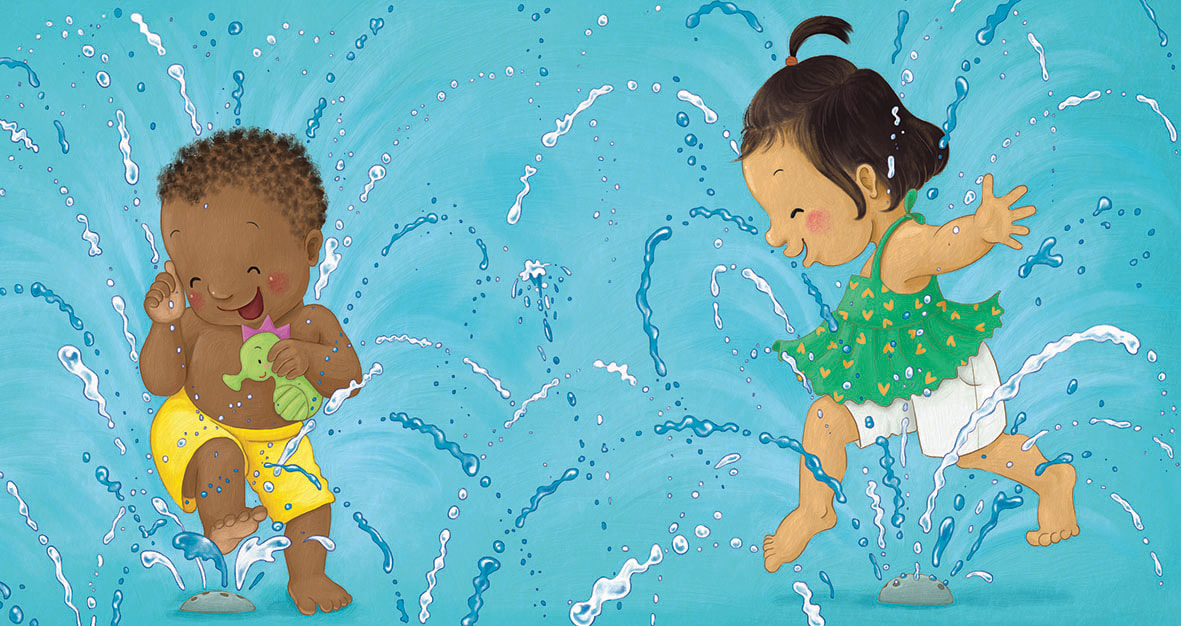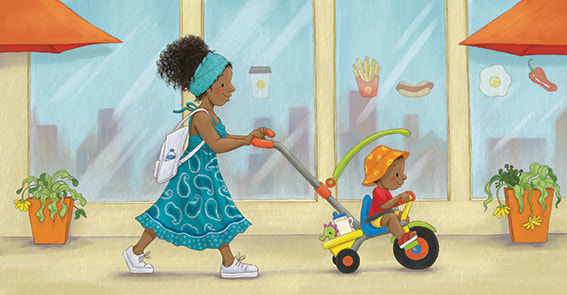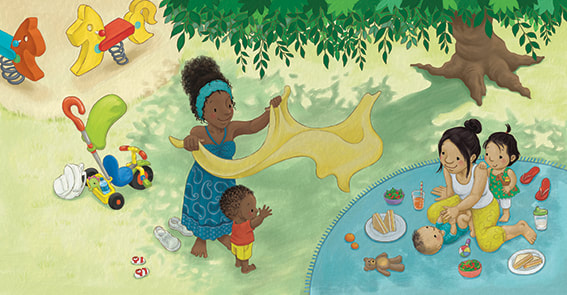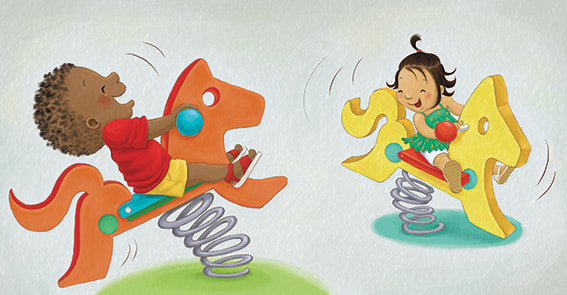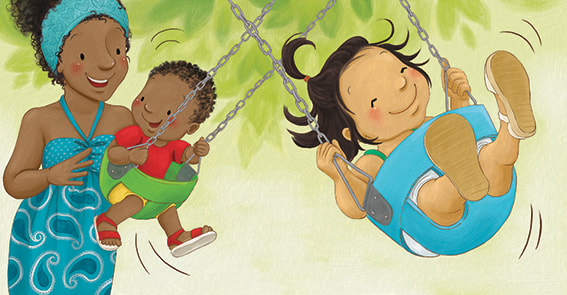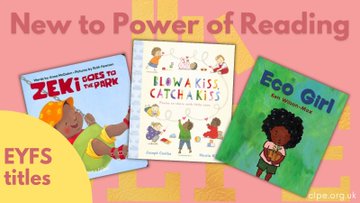Contrasting colours, feelings and textures
It's great to see critics notice the hot and cool contrast theme running through this little story.
The book opens with Zeki and his mum walking the visibly hot pavements on their way to seek shade in the park.
The book opens with Zeki and his mum walking the visibly hot pavements on their way to seek shade in the park.
Little readers paying close attention to the art will notice the hot dogs (!) and fries (!) on the restaurant window as they pass... it's so hot you could fry an egg! The poor plants are wilting.
In contrast, in the park the green leaves of a large tree and Yu's blue rug provide contrasting and welcome shade.
But little kids are less phased by heat than us and they head to the brignt orange and yellow ride-on's for more fun.
But Mommy is keeping an eye and they switch to the swings where the breeze and the shade help calm them again.
In contrast, in the park the green leaves of a large tree and Yu's blue rug provide contrasting and welcome shade.
But little kids are less phased by heat than us and they head to the brignt orange and yellow ride-on's for more fun.
But Mommy is keeping an eye and they switch to the swings where the breeze and the shade help calm them again.
The fun continues building awesome sand castles, and digging, so they have to wash off and cool down all over again... just in time for a picnic before heading home as the sun sets.
CLPE Power of Reading Choice 2023-24
|
Each year our teaching team selects new high-quality texts to add to our #PowerofReading books, and these fantastic titles from Anna McQuinn, Joseph Coelho and Ken Wilson Max
are our 23/24 #EYFS additions. |
For a book to be on our Power of Reading list it has to have many distinct and different elements. We work to put together a collection that contains books that are emotionally powerful; books with storylines and plots that allow opportunities to explore dilemmas, challenges, morality and ethics; protagonists that children can identify with. But above all, texts take you inescapably into the world of the book - a book you can lose yourself in. Our Power of Reading collection showcases a breadth of types of texts as well: narrative, poetry, traditional tales, texts with powerful illustrations, and interesting non-fiction texts.
All the books we choose have to lend themselves to sustained study in a primary classroom. We need to be able to see where we can offer in depth and real writing experiences, meaningful study of literary styles and rhythms, opportunities for response that is creative and open-ended, all whilst keeping children engaged with the characters and the story as a whole.
In Power of Reading sequences we don’t shoehorn in grammar tricks or comprehension exercises. The power of the study, the reason teachers tell us children are motivated and engaged to be readers and writers, is because the teaching sequences respect the authenticity of the text, scaffolding understanding and subject knowledge, showing children examples of real and powerful writing and text construction from which they can learn.
The Power of Reading list is the collective effort of our entire team. We are all passionate about books and literature, we are all keen readers and recent teachers with firm ideas about what we want to see in the collections. Before a book can be considered for Power of Reading it must be part of our Corebooks Collection. Every month, Phoebe, our Librarian, produces an “In Books” list of new books that have come into our Centre. Before they go on our library shelves, they are kept on a special trolley so that we can read and review them ourselves (if you’re visiting, look for the trolley – it is always out in the Literacy Library). For a book to go into the Core Collection it needs to be approved by Phoebe and at least one other person, and we need to agree which collection and age range it will go in. Once it is in the Core Collection then a book can go on the potential Power of Reading list. For it to be considered at least three of us (teachers and librarians) have to agree. We have to consider individual choices and the balance of the whole collection, make sure we have a range of text types, a range of authors, a balance of the new and the classic and books that reflect the realities of children in our classrooms. For each year group collection we only choose 12 books to go in the packs that teachers who come on our face to face Power of Reading training get to take away with them – although there are many, many more in the wider collection on the CLPE School Membership section of our website.
We have to be ruthless and that sometimes means we aren’t always happy. It’s hard when you love a book and someone else says “but I just can’t see the sequence” but to earn its place the book needs to be one that any teacher, in any classroom can pick up and plan with. That means the books on the Power of Reading are very special books that provide any reader who encounters them to develop a deep and meaningful connection with the text.
All the books we choose have to lend themselves to sustained study in a primary classroom. We need to be able to see where we can offer in depth and real writing experiences, meaningful study of literary styles and rhythms, opportunities for response that is creative and open-ended, all whilst keeping children engaged with the characters and the story as a whole.
In Power of Reading sequences we don’t shoehorn in grammar tricks or comprehension exercises. The power of the study, the reason teachers tell us children are motivated and engaged to be readers and writers, is because the teaching sequences respect the authenticity of the text, scaffolding understanding and subject knowledge, showing children examples of real and powerful writing and text construction from which they can learn.
The Power of Reading list is the collective effort of our entire team. We are all passionate about books and literature, we are all keen readers and recent teachers with firm ideas about what we want to see in the collections. Before a book can be considered for Power of Reading it must be part of our Corebooks Collection. Every month, Phoebe, our Librarian, produces an “In Books” list of new books that have come into our Centre. Before they go on our library shelves, they are kept on a special trolley so that we can read and review them ourselves (if you’re visiting, look for the trolley – it is always out in the Literacy Library). For a book to go into the Core Collection it needs to be approved by Phoebe and at least one other person, and we need to agree which collection and age range it will go in. Once it is in the Core Collection then a book can go on the potential Power of Reading list. For it to be considered at least three of us (teachers and librarians) have to agree. We have to consider individual choices and the balance of the whole collection, make sure we have a range of text types, a range of authors, a balance of the new and the classic and books that reflect the realities of children in our classrooms. For each year group collection we only choose 12 books to go in the packs that teachers who come on our face to face Power of Reading training get to take away with them – although there are many, many more in the wider collection on the CLPE School Membership section of our website.
We have to be ruthless and that sometimes means we aren’t always happy. It’s hard when you love a book and someone else says “but I just can’t see the sequence” but to earn its place the book needs to be one that any teacher, in any classroom can pick up and plan with. That means the books on the Power of Reading are very special books that provide any reader who encounters them to develop a deep and meaningful connection with the text.
